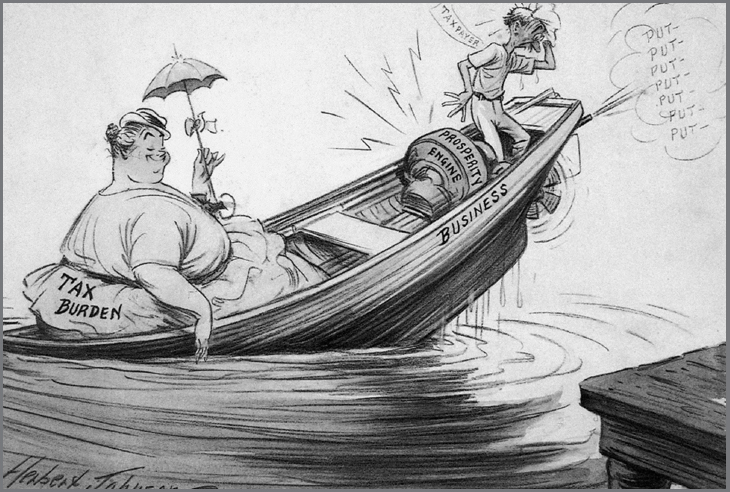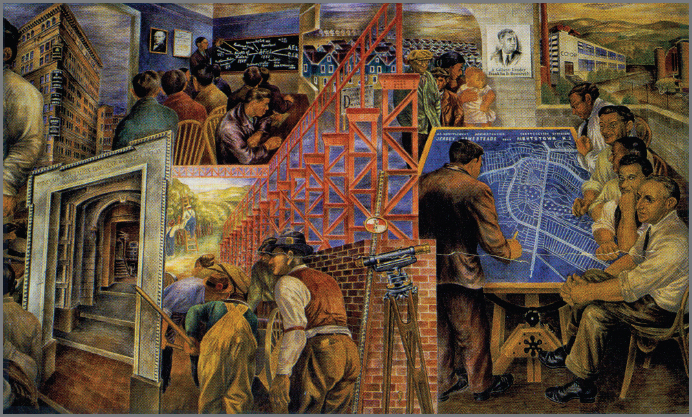America’s History: Printed Page 752
THINKING LIKE A HISTORIAN |  |
The New Deal and Public Works
More than half a dozen New Deal programs were devoted to building up the physical and cultural infrastructure of the country. The former included roads, bridges, dams, trails, and national parks. The latter included artwork, murals, plays, and other forms of literary expression. Examine the following documents and use them collectively to analyze the New Deal’s relationship to infrastructure, art, culture, and politics.
Harold L. Ickes, secretary of the interior, The New Democracy, 1934.
Our Government is no longer a laissez-faire Government, exercising traditional and more or less impersonal powers. There exists in Washington a sense of responsibility for the health, safety, and well-being of the people. … I believe that we are at the dawn of a day when the average man, woman, and child in the United States will have an opportunity for a happier and richer life. And it is just and desirable that this should be so. … We are not here merely to endure a purgatorial existence in anticipation of a beatific eternity after the grave closes on us. We are here with hopes and aspirations and legitimate desires that we are entitled to have satisfied to at least a reasonable degree. Nor will such a social program as we are discussing cause a strain on our economic system.
Herbert Johnson cartoon, Saturday Evening Post, 1935.
 The Granger Collection, New York.
The Granger Collection, New York.Federal Writers’ Project interview with a WPA draftsman, Newburyport, Massachusetts, June 25, 1939.
One reason people here don’t like the WPA is because they don’t understand it’s not all bums and drunks and aliens! Nobody ever explains to them that they’d never have had the new High School they’re so […] proud of if it hadn’t been for the WPA. They don’t stop to figure that new brick sidewalks wouldn’t be there, the shade trees wouldn’t be all dressed up to look at along High Street and all around town, if it weren’t for WPA projects. To most in this town, and I guess it’s not much different in this, than any other New England place, WPA’s just a racket, set up to give a bunch of loafers and drunks steady pay to indulge in their vices! They don’t stop to consider that on WPA are men and women who have traveled places and seen things, been educated and found their jobs folded up and nothing to replace them with.
Ben Shahn, WPA mural, 1938. This is part of a three-panel mural commissioned by the Works Progress Administration (WPA) and painted at a public school in Roosevelt, New Jersey, by the well-known artist Ben Shahn.
 Courtesy of Roosevelt Arts Project/Picture Research Consultants & Archives
Courtesy of Roosevelt Arts Project/Picture Research Consultants & ArchivesDavid E. Lilienthal, TVA: Democracy on the March, 1944. Written by the former chairman of the Tennessee Valley Authority.
I believe men may learn to work in harmony with the forces of nature, neither despoiling what God has given nor helpless to put them to use. I believe in the great potentialities for well-being of the machine and technology and science; and though they do hold a real threat of enslavement and frustration for the human spirit, I believe those dangers can be averted. I believe that through the practice of democracy the world of technology holds out the greatest opportunity in all history for the development of the individual, according to his own talents, aspirations, and willingness to carry the responsibilities of a free man. …
Such are the things that have happened in the Tennessee Valley. Here men and science and organizational skills applied to the resources of waters, land, forests, and minerals have yielded great benefits for the people. And it is just such fruits of technology and resources that people all over the world will, more and more, demand for themselves. That people believe these things can be theirs — this it is that constitutes the real revolution of our time, the dominant political fact of the generation that lies ahead.
Sources: (1) Harold L. Ickes, The New Democracy (New York: W. W. Norton & Company Inc., 1934), 60–61; (3) Federal Writers’ Project Life Histories, Library of Congress, lcweb2.loc.gov/ammem/wpaintro/wpahome.html; (5) David E. Lilienthal, TVA: Democracy on the March (New York: Harper & Row Publishers, 1944), xxii, 3.
ANALYZING THE EVIDENCE
Question
What sorts of reasons do the authors of sources 1 and 5 give for supporting New Deal programs? What does the “good life” look like in their view, and how is it connected to the New Deal?
Question
What do sources 2 and 3 suggest about possible opposition to New Deal programs? What sorts of public burdens do New Deal opponents envision?
Question
Consider source 4. What can we learn from a mural about the spirit of the New Deal? Identity specific elements of the mural and think about what they might signify about the society the muralist envisioned. What kind of faith in the federal government does the mural reveal?
PUTTING IT ALL TOGETHER
Question
Using evidence from the sources in this feature, alongside material from the chapter and from your knowledge of the period, write an essay in which you analyze Americans’ attitudes toward New Deal public works projects. If they were positive or optimistic, what was the basis of their optimism? If they were critical, what was the basis of their criticism? From these sources, can you identify a governing spirit of New Deal reform?